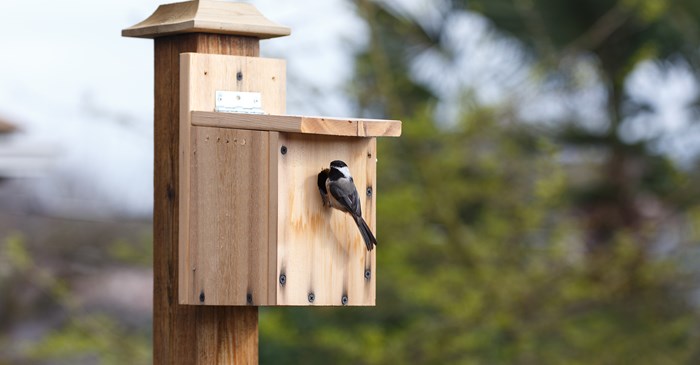To increase the number and variety of birds visiting your feeders regularly, remember that they require adequate shelter, cover, and nesting accommodations in addition to nutritious food. By installing human-made birdhouses, you encourage breeding in areas where natural nesting habitats are slowly disappearing. Birdhouses should imitate the natural cavities for nesting and if you are lucky and pick the right spot, you can watch a bird throughout its breeding cycle.
In the wild, some species of birds nest in tree holes, others in natural cavities, or in holes they create themselves. Some birds even count on other birds, like the Eastern Bluebird, which relies largely on Woodpeckers to dig the cavities in the trees or fence posts for their nests. However, the house sparrow and starlings are known to compete with the bluebirds for these prime nesting sites.
Chickadees, titmice, wrens, bluebirds, purple martins, nuthatches, starlings, sparrows, some flycatchers, swallows, owls, and woodpeckers use birdhouses. The most successful locations are those that mirror the type, size and location of natural nesting cavities, and this often varies by bird. For example, to attract the Eastern Screech Owl, you would need to mount the nesting box as high as ten feet! But most birdhouses should be placed about five or six feet high, convenient enough for you remove and clean them at the end of each breeding season. To be absolutely sure you have selected the right location for your birdhouse, you may need to do some "testing." This fall, place birdhouses at various intervals in your landscape and then observe them through the winter and early spring.
The box should be placed in open areas, but near a wooded area for cover and where nesting materials will be available close by. Some shelter from the elements is also optimum, so be sure to face the opening away from prevailing winds. After one season of testing, observe the birdhouses that are used in breeding season, which is usually late spring through summer, and these will be the preferred locations.
Studying the natural habitat, nest sites and nest types of the various birds that visit your landscape will give you copious clues as to the best type and location for your birdhouses. For example, the Blue Jay breeds in woodlands and in both rural and suburban locations. Their nest location is typically in tree crotches or on branches. The type of nest they prefer in nature is an open cup made of twigs and bark, lined with mosses or lichens, roots, mud or leaves. It’s best to study the habits of the birds you wish to attract and use their natural habitat and preferences as a guide, and you’ll be listening to the sweet tunes of baby birds and adding a new generation of birds to watch with each new breeding season!
